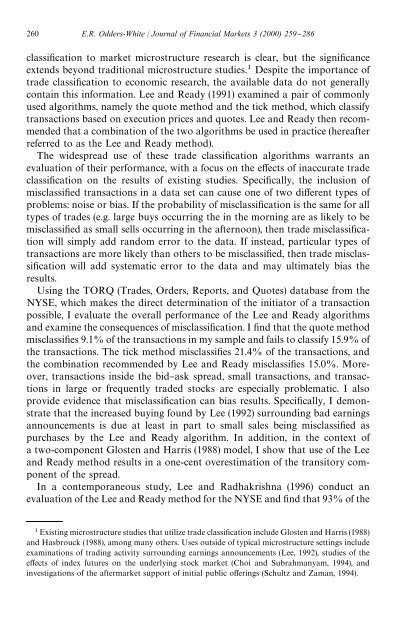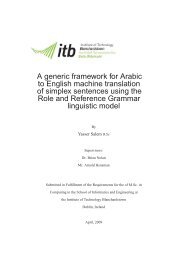On the occurrence and consequences of inaccurate ... - Acsu Buffalo
On the occurrence and consequences of inaccurate ... - Acsu Buffalo
On the occurrence and consequences of inaccurate ... - Acsu Buffalo
Create successful ePaper yourself
Turn your PDF publications into a flip-book with our unique Google optimized e-Paper software.
260 E.R. Odders-White / Journal <strong>of</strong> Financial Markets 3 (2000) 259}286<br />
classi"cation to market microstructure research is clear, but <strong>the</strong> signi"cance<br />
extends beyond traditional microstructure studies. Despite <strong>the</strong> importance <strong>of</strong><br />
trade classi"cation to economic research, <strong>the</strong> available data do not generally<br />
contain this information. Lee <strong>and</strong> Ready (1991) examined a pair <strong>of</strong> commonly<br />
used algorithms, namely <strong>the</strong> quote method <strong>and</strong> <strong>the</strong> tick method, which classify<br />
transactions based on execution prices <strong>and</strong> quotes. Lee <strong>and</strong> Ready <strong>the</strong>n recommended<br />
that a combination <strong>of</strong> <strong>the</strong> two algorithms be used in practice (hereafter<br />
referred to as <strong>the</strong> Lee <strong>and</strong> Ready method).<br />
The widespread use <strong>of</strong> <strong>the</strong>se trade classi"cation algorithms warrants an<br />
evaluation <strong>of</strong> <strong>the</strong>ir performance, with a focus on <strong>the</strong> e!ects <strong>of</strong> <strong>inaccurate</strong> trade<br />
classi"cation on <strong>the</strong> results <strong>of</strong> existing studies. Speci"cally, <strong>the</strong> inclusion <strong>of</strong><br />
misclassi"ed transactions in a data set can cause one <strong>of</strong> two di!erent types <strong>of</strong><br />
problems: noise or bias. If <strong>the</strong> probability <strong>of</strong> misclassi"cation is <strong>the</strong> same for all<br />
types <strong>of</strong> trades (e.g. large buys occurring <strong>the</strong> in <strong>the</strong> morning are as likely to be<br />
misclassi"ed as small sells occurring in <strong>the</strong> afternoon), <strong>the</strong>n trade misclassi"cation<br />
will simply add r<strong>and</strong>om error to <strong>the</strong> data. If instead, particular types <strong>of</strong><br />
transactions are more likely than o<strong>the</strong>rs to be misclassi"ed, <strong>the</strong>n trade misclassi"cation<br />
will add systematic error to <strong>the</strong> data <strong>and</strong> may ultimately bias <strong>the</strong><br />
results.<br />
Using <strong>the</strong> TORQ (Trades, Orders, Reports, <strong>and</strong> Quotes) database from <strong>the</strong><br />
NYSE, which makes <strong>the</strong> direct determination <strong>of</strong> <strong>the</strong> initiator <strong>of</strong> a transaction<br />
possible, I evaluate <strong>the</strong> overall performance <strong>of</strong> <strong>the</strong> Lee <strong>and</strong> Ready algorithms<br />
<strong>and</strong> examine <strong>the</strong> <strong>consequences</strong> <strong>of</strong> misclassi"cation. I "nd that <strong>the</strong> quote method<br />
misclassi"es 9.1% <strong>of</strong> <strong>the</strong> transactions in my sample <strong>and</strong> fails to classify 15.9% <strong>of</strong><br />
<strong>the</strong> transactions. The tick method misclassi"es 21.4% <strong>of</strong> <strong>the</strong> transactions, <strong>and</strong><br />
<strong>the</strong> combination recommended by Lee <strong>and</strong> Ready misclassi"es 15.0%. Moreover,<br />
transactions inside <strong>the</strong> bid}ask spread, small transactions, <strong>and</strong> transactions<br />
in large or frequently traded stocks are especially problematic. I also<br />
provide evidence that misclassi"cation can bias results. Speci"cally, I demonstrate<br />
that <strong>the</strong> increased buying found by Lee (1992) surrounding bad earnings<br />
announcements is due at least in part to small sales being misclassi"ed as<br />
purchases by <strong>the</strong> Lee <strong>and</strong> Ready algorithm. In addition, in <strong>the</strong> context <strong>of</strong><br />
a two-component Glosten <strong>and</strong> Harris (1988) model, I show that use <strong>of</strong> <strong>the</strong> Lee<br />
<strong>and</strong> Ready method results in a one-cent overestimation <strong>of</strong> <strong>the</strong> transitory component<br />
<strong>of</strong> <strong>the</strong> spread.<br />
In a contemporaneous study, Lee <strong>and</strong> Radhakrishna (1996) conduct an<br />
evaluation <strong>of</strong> <strong>the</strong> Lee <strong>and</strong> Ready method for <strong>the</strong> NYSE <strong>and</strong> "nd that 93% <strong>of</strong> <strong>the</strong><br />
Existing microstructure studies that utilize trade classi"cation include Glosten <strong>and</strong> Harris (1988)<br />
<strong>and</strong> Hasbrouck (1988), among many o<strong>the</strong>rs. Uses outside <strong>of</strong> typical microstructure settings include<br />
examinations <strong>of</strong> trading activity surrounding earnings announcements (Lee, 1992), studies <strong>of</strong> <strong>the</strong><br />
e!ects <strong>of</strong> index futures on <strong>the</strong> underlying stock market (Choi <strong>and</strong> Subrahmanyam, 1994), <strong>and</strong><br />
investigations <strong>of</strong> <strong>the</strong> aftermarket support <strong>of</strong> initial public o!erings (Schultz <strong>and</strong> Zaman, 1994).
















